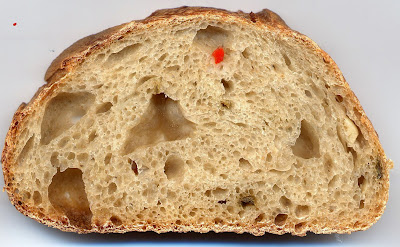...y que hay oro y cobre. También hay mucho aji, que es su pimienta, della que vale más que pimienta, y toda la gente no come sin ella, que la halla muy sana; puédense cargar cincuenta carabelas cada año en aquella Española.
Diario de abordo, El Gran Almirante, 15 de enero 1493, isla de la Española
... and there is gold and copper. There is also a great deal of aji, that is their pepper, that is worth more than pepper, and all the people cannot eat without it, they find it very healthy; there could be fifty caravels loaded every year in that [island of] Española.
Ships Log, The great admiral (Christopher Columbus), January 15, 1493, Hispañola (Current Dominican Republic)
Thus the great admiral was filled with visions of riches. Offhandedly he mentions gold and copper. However, he computes the number of caravels that could be loaded with aji, the native pepper. Imagine the demand for pepper in Europe, and how Spain could establish their own trade monopoly without encountering the Portuguese, who held the sea routes to India!
There was one problem with the plan. Pepper (piperum nigrum) grows only within 20 degrees of the equator, and only with 2 meters of rainfall. The pepper plant is a climbing vine that requires careful cultivation for 3-5 years before it bears fruit. Realistically, the East Indies were only reasonable source for the spice. To get the valued black pepper needed the power of kingdoms, navigation outposts, colonies, and of course, implied state monopolies. Not to mention the labor required to tend the plant, which would come from slaves.
Chile, or capsicum annuum, however, could grow without much effort in southern Spain. Within a few weeks of planting anyone could have hot spice. Within a few years of Columbus bringing visions of "fifty caravels a year" to Spain, peasants in what is now Hungary (40-45 degrees north) were growing peppers. No navigation outposts, no colonies, no monopolies. Decentralized.
Which suggests today we will make red pepper (capsicum annuum) bread...
The plan
In the last baking we found it was difficult to mix and bake over 5kg of dough. The mixer was more than adequate, but the lack of a convection oven slows the baking. Since we want a vegetable bread with a Italian rolls, we will make a common mix, then divide and hand mix the vegetables into one part of the dough.
-
Pre-Treatment for 1.6kg of dough
Add yeast, salt, water and flour to make 4.8 kg total
Divide into equal parts
Rising and forming for Italian rolls
Hand fold vegetables into dough
Rising and forming
Bake
Pre Treatment
This is a 60% AR dough without yeast that allows the amylase in Amapola Harina Por Pan to work on the flour overnight to permit a faster rise with less yeast.
300 gm whole wheat flour
700 gm Amapola Harina Por Pan
600 gm water at 27C
Mix for 9 minutes at 1st speed and allow to stand
Mixing
The pre-treatment dough was allowed to act for 12 hours. At the end of the period, bread flour, salt and yeast mix was added. The ingredients were computed to make 4.8kg of dough
1.2 kg of water at 40C
24 gm La Vahiné yeast. (This is 0.8% of total flour weight, a little high for my personal practice, but recognizes the additional salt that may be in the vegetables. Additional salt causes water to flow out of the yeast cells by osmotic pressure and slows their action.)
10 gm sugar
Mix the above and let stand for 20 minutes then add to the pre-treatment. Mix for 5 minutes to make a batter. Then:
60 gm salt (2% of flour weight)
2.0 kg Pillsbury bread flour
add the salt and mix
The filling
We are estimating about 2400 gm of basic dough that will need approximately 10% of its weight in filling. The idea is to build layers of flavors that cook with the dough and infuse the bread with aromas.
Take
- 100 gm whole clove garlic
- sprinkle of whole cumin seeds
- 30 cc of virgin olive oil
Then add cold:
- 100 gm drained Pimiento Morron (Vitter Brand) chopped
- 60 gm diced fresh onion
- 3-4 gm coarse salt
- Strong dash of black pepper
- Strong dash of crushed oregano leaves
- 15-20 cc wine vinegar
Toss this mixture and let stand so the salt draws water from the onion and rehydrates the oregano.
Rising and forming
One-half the dough is left to rise in 1-hour periods (at 27C) while the other have is stretched on the board until it is 2-3cm thick. The pepper, onion, and garlic mix is spread on the stretched dough, draining as much liquid as possible. (Dusting the spread with flour at this point is also OK.)
This mix was also allowed to rise through two 1-hour risings and knock downs. At the end of the second rising, it looks like this:
The garlic, pimiento, and onion dough was divided into 4 loaves of approximately 660gm each and placed in couchette to rise.
Baking
Regular Italian rolls were rolled from boule into small pistolet type rolls, docked, and baked at 450F (232C). The loaves were carefully placed on baking screens, docked, and baked at the same temperature.
Baking time for rolls was approximately 15-18 minutes. Baking time for the loaves was approximately 22-25 minutes, rotating top rack with the bottom rack after 15 minutes.
Results
Bloom and color were excellent with a wonderful aroma when baking. The crumb was well formed with well defined pieces of garlic and pimiento.
Now, just go to Meats-and-More or La Ceiba, get some pavochón o lechón asado and have a sandwich.

No comments:
Post a Comment